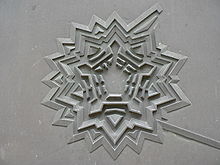Concentric castle

A concentric castle is a
Concentric castles resemble one castle nested inside the other, thus creating an
Development


Surrounding fortresses or towns with a series of
Historians (in particular
While a concentric castle has double walls and towers on all sides, the defences need not be uniform in all directions. There can still be a concentration of defences at a vulnerable point. At Krak des Chevaliers, this is the case at the southern side, where the terrain permits an attacker to deploy siege engines. Also, the gate and posterns are typically strengthened using a bent entrance or flanking towers.
Concentric castles were expensive to build, so that only the powerful military orders, the
Concentric castles appeared in Europe in the 13th century, with the castles built in Wales by Edward I providing some outstanding examples, in particular Beaumaris Castle, a "perfect concentric castle",[4] albeit unfinished. As Beaumaris was built on flat terrain rather than a spur, it was both necessary and possible to build walls and towers facing in all directions, giving a very regular, almost square, floor plan to the castle. Some influence from crusader fortification has been conjectured, but the amount of technology transfer from the East and much earlier Byzantine examples remains controversial among historians.[1]
Similar structures
In the German-speaking states of the Holy Roman Empire, many castles had double curtain walls with a narrow ward between them, referred to as a Zwinger. These were added at vulnerable points like the gate but were rarely as fully developed as in the concentric castles in Wales or the Crusader castles.
The principle of an outer and inner wall was also used in fortified cities, such as the
The concept of mutually reinforcing lines of defence with flanking fire was continued in later periods, such as the early modern fortifications of
Citadels from before and during the Reconquista in Spain and Portugal also have fortifications similar to concentric castles found elsewhere in Europe.
Examples of concentric castles
-
Castle of Margat (Syria), 1062–
-
Belvoir Castle (Israel), 1150
-
Münzenberg Castle (Hesse), 1162
-
Kidwelly Castle, south-west Wales, 13th century
-
Rhuddlan Castle, north of Wales, 1277
-
Harlech Castle, west of Wales, 1282–
-
Beaumaris Castle, on the island of Anglesey at the north-west of Wales, 1295
-
The Byzantine castle of Korykos from the sea c.11th cent. AD. It featured fully concentric features a century before the first examples of concentric fortifications were seen in the West
-
Caerphilly Castle, south of Wales, 13th century
See also
- Buhen (ancient Egyptian stronghold)
References
- ^ ISBN 0-521-79913-9.
- OCLC 254999395.
- ISBN 978-1846033490.
- ISBN 978-0-521-32932-3.









